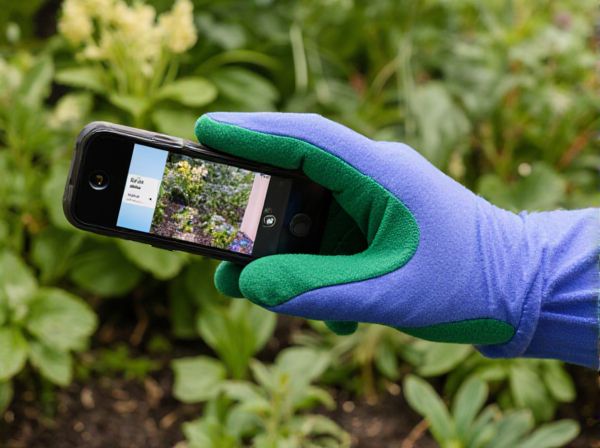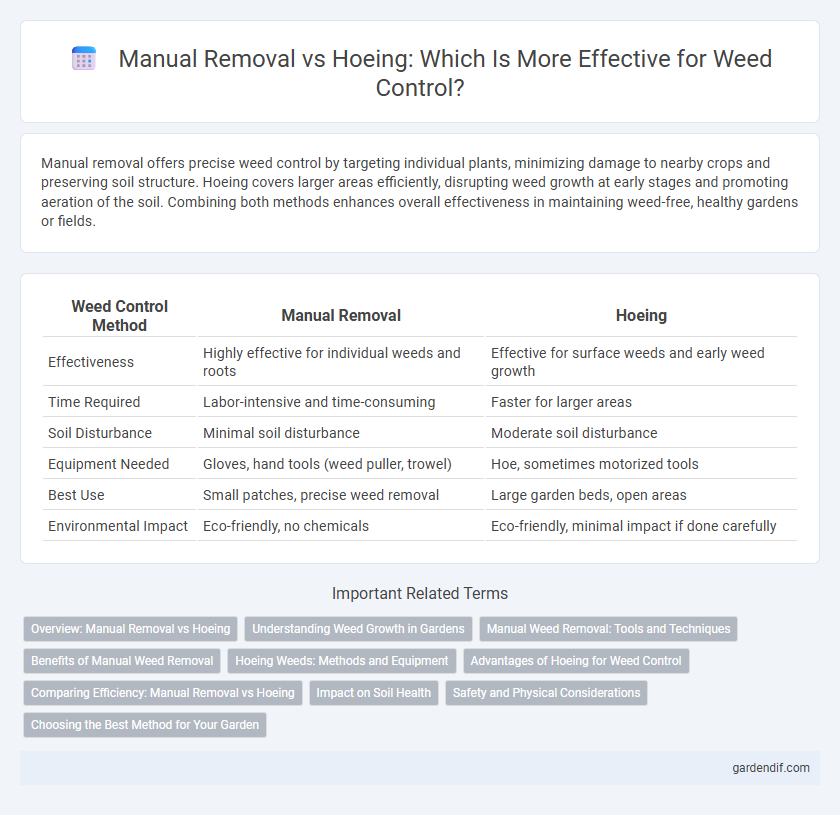
Manual removal vs Hoeing Illustration
Manual removal offers precise weed control by targeting individual plants, minimizing damage to nearby crops and preserving soil structure. Hoeing covers larger areas efficiently, disrupting weed growth at early stages and promoting aeration of the soil. Combining both methods enhances overall effectiveness in maintaining weed-free, healthy gardens or fields.
Table of Comparison
| Weed Control Method | Manual Removal | Hoeing |
|---|---|---|
| Effectiveness | Highly effective for individual weeds and roots | Effective for surface weeds and early weed growth |
| Time Required | Labor-intensive and time-consuming | Faster for larger areas |
| Soil Disturbance | Minimal soil disturbance | Moderate soil disturbance |
| Equipment Needed | Gloves, hand tools (weed puller, trowel) | Hoe, sometimes motorized tools |
| Best Use | Small patches, precise weed removal | Large garden beds, open areas |
| Environmental Impact | Eco-friendly, no chemicals | Eco-friendly, minimal impact if done carefully |
Overview: Manual Removal vs Hoeing
Manual removal involves physically pulling weeds by hand, targeting individual plants to ensure complete root extraction and reduce regrowth. Hoeing uses a sharp blade to cut weeds just below the soil surface, effectively disrupting weed growth and preventing seed development. Both methods offer efficient weed control, with manual removal suited for small-scale areas and hoeing ideal for larger, open spaces.
Understanding Weed Growth in Gardens
Weed growth in gardens thrives in disturbed soil where seeds can easily germinate, making early intervention critical for control. Manual removal targets weeds by uprooting them entirely, including roots, which prevents regrowth and reduces seed spread. Hoeing disrupts young weeds just below the soil surface, effectively cutting them off before they establish, but may require frequent repetition to manage persistent weed species.
Manual Weed Removal: Tools and Techniques
Manual weed removal involves the use of tools such as hand trowels, weed pullers, and gloves to effectively extract weeds from garden beds and lawns by targeting roots to prevent regrowth. Techniques include gripping the weed at its base and pulling gently, loosening soil around stubborn roots with a hand fork, and cutting off weeds before seed production to minimize spread. Proper manual removal reduces chemical usage, supports soil health, and provides precise control over invasive species in small-scale or sensitive planting areas.
Benefits of Manual Weed Removal
Manual weed removal offers precise control by targeting individual weeds without disturbing surrounding plants, minimizing soil disruption and promoting healthier root development. This method reduces the risk of herbicide resistance and chemical runoff, making it an eco-friendly option for sustainable gardening. Furthermore, manual weeding enables early detection of weed infestations, allowing timely intervention and preventing extensive spread.
Hoeing Weeds: Methods and Equipment
Hoeing weeds involves using specialized tools like oscillating hoes, scuffle hoes, or collinear hoes designed to cut weed roots below the soil surface, preventing regrowth effectively. Mechanical hoeing disrupts weed seedlings early in their growth stage, minimizing competition for nutrients and moisture with crops or garden plants. Proper technique includes shallow, frequent passes to avoid soil disturbance and promote healthy soil aeration, making it an efficient method for sustainable weed management.
Advantages of Hoeing for Weed Control
Hoeing offers efficient weed control by disturbing weed seedlings at the soil surface, preventing their establishment and reducing competition with crops. This method minimizes soil disturbance compared to manual removal, preserving soil structure and moisture levels while enhancing aeration. Hoeing allows for rapid coverage of larger areas, making it a time-saving option for managing weeds in agricultural and garden settings.
Comparing Efficiency: Manual Removal vs Hoeing
Manual removal offers precision by targeting individual weeds, making it highly effective for small infestations and minimizing soil disturbance. Hoeing accelerates the process over larger areas by severing weed roots near the surface but may miss deeply rooted weeds, reducing long-term effectiveness. Efficiency depends on infestation size, with manual removal favored for targeted control and hoeing preferred for rapid clearing of extensive weed populations.
Impact on Soil Health
Manual removal of weeds minimizes soil disturbance, preserving soil structure and microbial life essential for nutrient cycling. Hoeing disrupts the topsoil layer, potentially harming beneficial organisms and increasing soil erosion risks. Selecting manual removal supports long-term soil health by maintaining organic matter and reducing compaction.
Safety and Physical Considerations
Manual removal of weeds reduces the risk of chemical exposure, making it safer for gardeners, especially in residential or organic settings. Hoeing requires more physical effort and can strain the back and arms if done for extended periods, whereas hand-pulling allows for targeted removal with less repetitive motion stress. Both methods demand proper posture and tools to minimize injury and enhance efficiency during weed control.
Choosing the Best Method for Your Garden
Manual removal ensures precise targeting of weeds, making it ideal for delicate garden beds and small areas where plant roots are close together. Hoeing offers efficiency for larger spaces, disturbing soil less deeply while cutting weed stems just below the surface to prevent regrowth. Consider soil type, weed species, and garden size when choosing between manual removal and hoeing to maximize weed control and minimize damage to desirable plants.
Manual removal vs Hoeing Infographic

 gardendif.com
gardendif.com